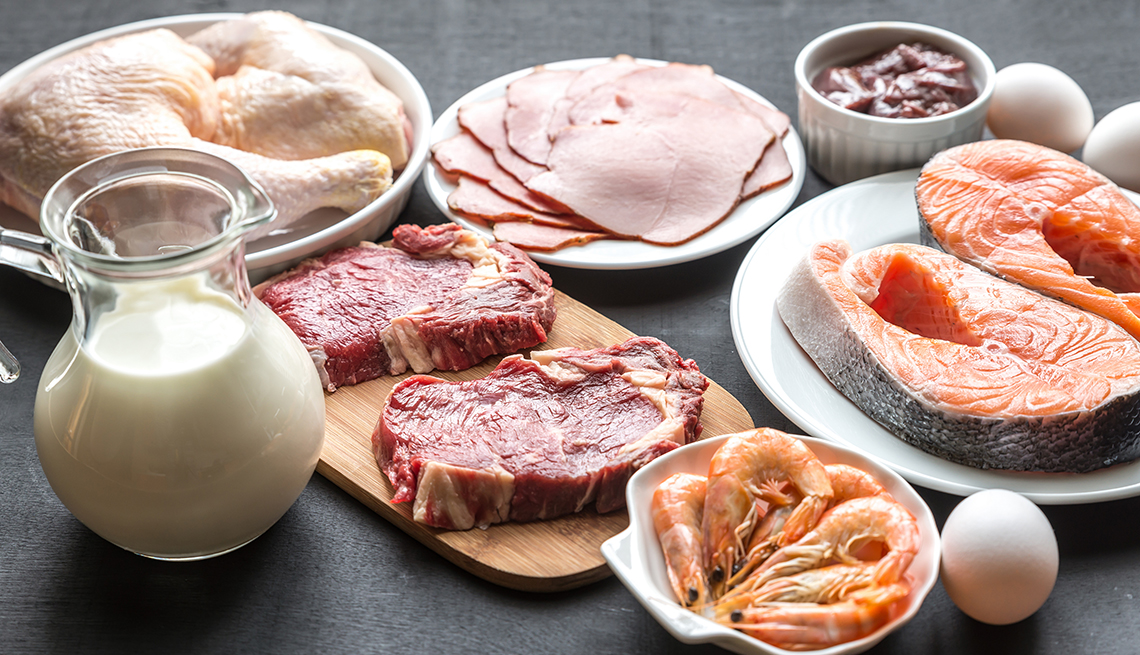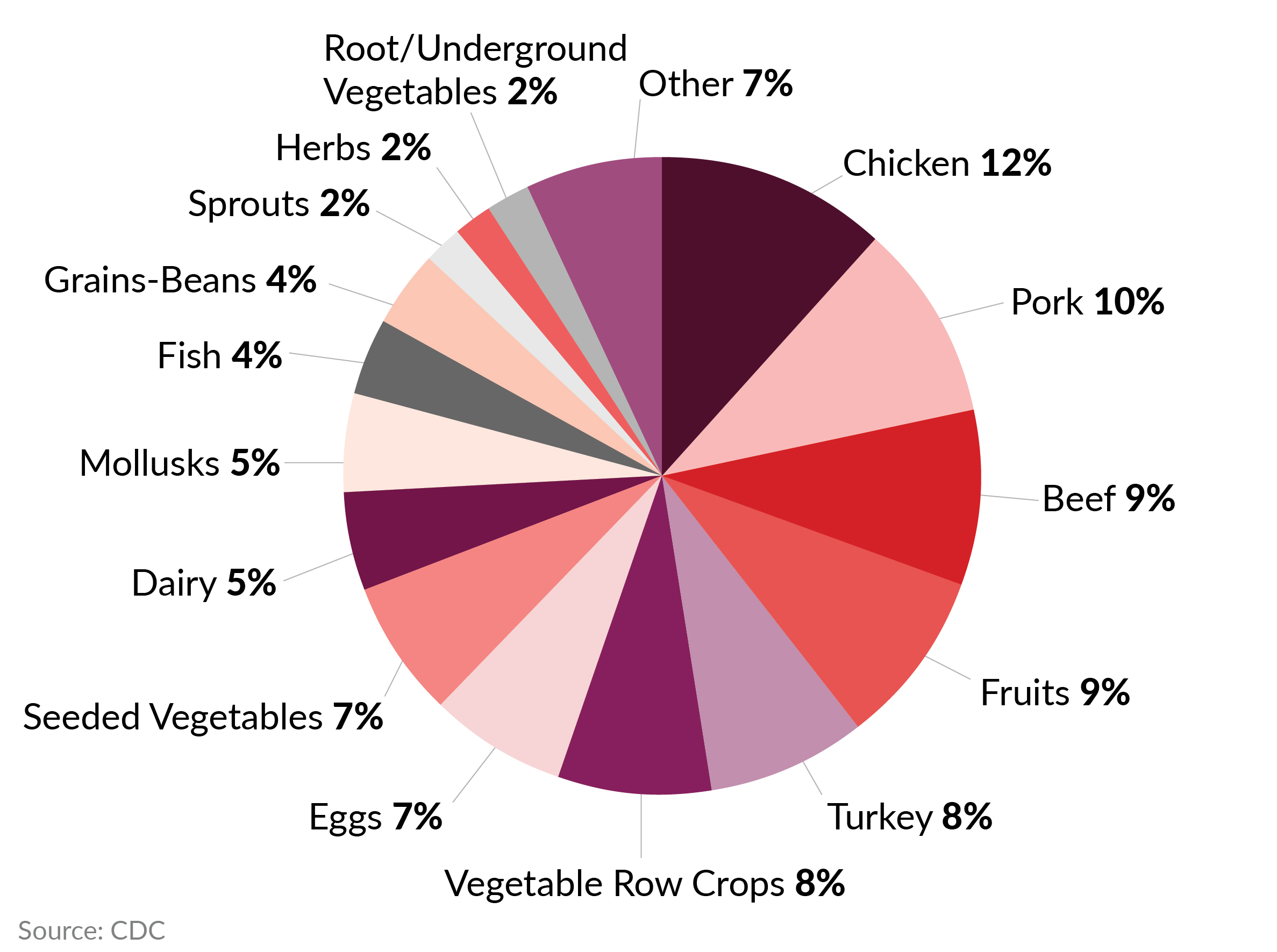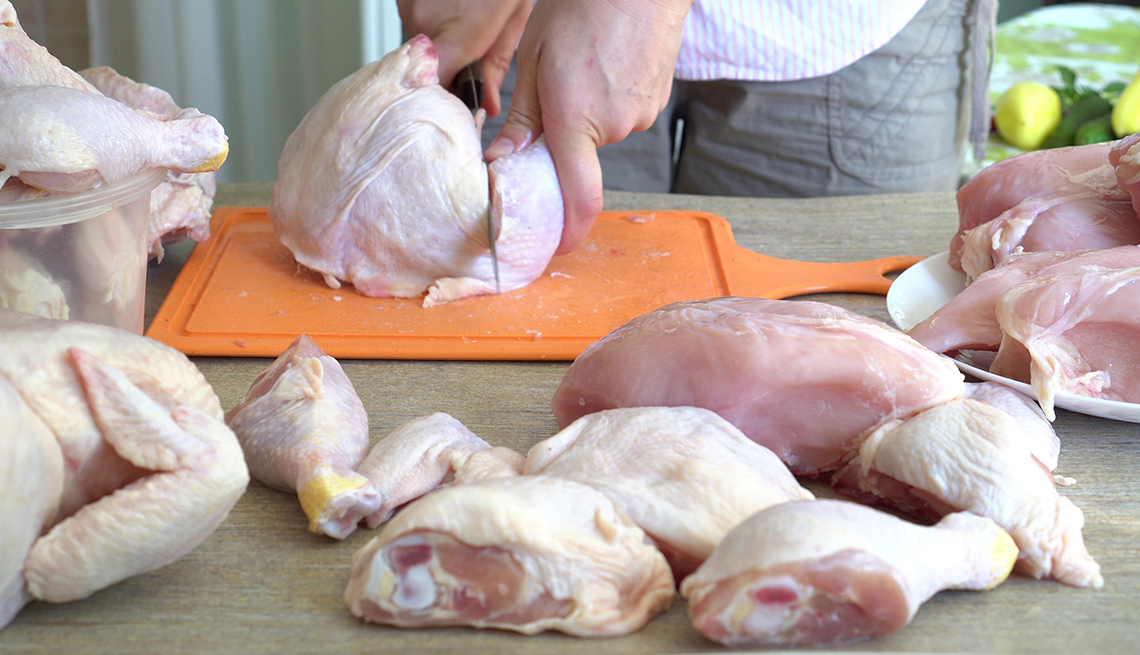Can Eating Raw Beef Give You Food Poisoning

Getty Images
En español | Catching an intestinal illness from something you eat is unpleasant at whatsoever age, just the stakes abound college the older you become, the U.Southward. Centers for Disease Control and Prevention (CDC) warns.
"Older adults in general are more than probable to have severe illness [from food poisoning] that could land them in the infirmary," says Patricia Griffin, M.D., chief of the CDC'south Enteric Diseases Epidemiology co-operative, which tracks foodborne illnesses. Almost half of people 65 and older with a confirmed foodborne illness caused by salmonella, campylobacter, listeria or E. coli finish up hospitalized, according to the CDC.
Equally you age, your immune system slows downwardly, curbing its ability to fight off germs. You're also more than likely to develop a chronic wellness condition, such as diabetes or heart affliction, when you're older. Both factors increase the risk of getting food poisoning and developing a serious illness from it. Fifty-fifty otherwise healthy older adults who take stomach-acid reducers may be creating a dangerous situation for themselves, Griffin adds, considering stomach acid helps kill harmful germs plant in foods.
Top Foods that Caused Illnesses 2009-2018

"Many older adults are quite healthy and don't retrieve of themselves as having increased run a risk," she says. "Simply they should recognize that as we all age, our immune system becomes a little more than sluggish, and nosotros need to have more than precautions to prevent ourselves from getting sick."
A peak precaution from the CDC is to melt food until information technology reaches its safe internal temperature, to impale any harmful bacteria, viruses or parasites that may be present. Other safety measures include washing your easily with soap and water for 20 seconds before preparing food, rinsing fresh produce nether running water earlier eating it and avoiding cross-contamination in the kitchen — in item, raw meat, poultry, seafood and eggs — when preparing meals.
Here are seven types of foods that the CDC warns can cause intestinal illness, along with the virtually mutual illness-causing germs associated with each and safety tips to avoid them.
one. Craven, beef, pork and turkey
Undercooking and cross-contagion are the two biggest risks posed past meats. Wash your easily; continue raw meat away from other ingredients; and cook chicken, beef, pork and turkey to safe temperatures. The CDC recommends using a cooking thermometer, though Griffin acknowledges that not everyone has 1 or uses it regularly.

Getty Images
Condom minimum cooking temperatures
• Basis beef, pork, veal, lamb:160 degrees
• Ground chicken, turkey: 165 degrees
• Steaks, roasts, chops:145 degrees
• Poultry:165 degrees
• Fresh pork, ham:145 degrees
• Precooked ham:165 degrees
• Egg dishes:160 degrees
• Leftovers, casseroles: 165 degrees
• Fish with fins:145 degrees
Source: Foodsafety.gov
"You have to rely oftentimes on getting something steaming hot that looks to you well cooked," she says. "A thermometer is best. But cooking your meat products really well is very of import."
Common foodborne germs:Campylobacter, Clostridium perfringens, E. coli, salmonella, Yersinia
Prophylactic tips: Ignore recipes that advise rinsing raw meats with water. The practice doesn't make your food any safer, and splashed h2o can spread germs from the raw meat to other food, utensils and surfaces.
E'er make certain your meat is sufficiently cooked. Older adults who prefer the taste of rare beef or pork are taking a hazard, Griffin says.
Leftovers should exist refrigerated at 40 degrees or colder inside two hours of preparation. Large cuts of meat should be portioned into pocket-size quantities to cool fast plenty and foreclose bacteria from growing.
two. Fruits and vegetables
Produce can selection up germs anywhere along the way, from the farm where information technology was grown to the store where it was sold — even from your kitchen counter once you get it dwelling house. Proper washing is the key to condom.
"On a per-serving basis, raw vegetables are not horribly risky except for certain ones, like sprouts," Griffin says. "Vegetables and fruit are a really of import part of a healthy diet, and there are so many wonderful ways to cook vegetables, and they are delicious."
Common foodborne germs:Salmonella, Due east. coli, listeria
Prophylactic tips: Earlier and after preparing whatever produce, wash your hands for at least 20 seconds with warm lather and h2o. Cutting away whatsoever damaged or hobbling areas earlier preparing or eating.
When washing produce, ever employ running water. Soaking may remove the germs initially, but the now-tainted h2o tin can recontaminate the fruits and vegetables equally well as contaminate nearby surfaces. The U.Due south. Food and Drug Administration doesn't recommend using soap, detergent or commercial produce wash.
iii. Raw milk and cheese products
The routing availability of pasteurized milk became widespread in the U.S. by the 1950s and significantly reduced the number of people who became ill from raw milk and raw-milk products such every bit soft cheeses. The pasteurization process involves heating raw milk to a loftier enough temperature for a long enough time to impale dangerous particles, according to the CDC.
"Unpasteurized milk is risky because if you make a mistake with 1 or a few cows, you may non simply go that udder perfectly make clean, and then you've contaminated that entire batch," Griffin says.
Although the pasteurization procedure inactivates some of the milk's enzymes, scientists practice non believe those enzymes are critical to dairy health benefits.
Common foodborne germs:Brucella, campylobacter, Cryptosporidium, East. coli, listeria, salmonella
Safety tips: If y'all have raw milk, you can pasteurize it at home by heating information technology to 165 degrees for 15 seconds using an oven or double boiler. Yous can also eat raw cheese safely if you cook it thoroughly.
4. Eggs
Eggs usually become contaminated when a hen has an infection around the tissues of its ovaries, which tin can innovatesalmonella into its egg. Eggs are less likely to exist contaminated today, though, than they were in the 1980s and early on 1990s because producers take worked to decrease infections that cause the leaner.
"Virtually batches of eggs are going to be completely safe," Griffin says. "But some batches are going to be from a chicken that was stressed enough thatsalmonella was coming out every bit they laid their egg, and your take chances of getting sick is going to be increased."
Common foodborne germ:Salmonella
Safety tips: Avert foods that contain raw or undercooked eggs, like handmade (not commercially bottled) Caesar salad dressing, eggnog and raw dough. Cook eggs until the yolks and whites are firm, and keep them refrigerated at a minimum of twoscore degrees.
5. Seafood and raw shellfish
Vibrio are bacteria that live in healthy seawater, so shellfish containing vibrio aren't technically contaminated. Still, the bacteria tin can atomic number 82 to an infection called vibriosis, which poses significant health risks to those 65 and older. Contaminated shellfish can also incorporate norovirus, which can cause symptoms in older adults that may lead to dehydration.

Getty Images
Mutual causes of foodborne intestinal illness
• Brucella: bacteria establish in raw milk, milk products
• Campylobacter: bacteria found on raw poultry
• Clostridium perfringens: bacteria plant on raw meat, poultry
• Cryptosporidium: parasite usually spread past water
• E. coli: leaner found outdoors, on nutrient and in intestines of animals
• Listeria: bacteria frequently found in dairy products, produce
• Norovirus: virus often found in shellfish, produce
• Salmonella: leaner establish in a variety of foods, including eggs
• Vibrio: leaner found in raw, undercooked oysters
• Yersinia: leaner institute in raw, undercooked pork
Source: Centers for Disease Command and Prevention
Although undercooked fish has not been a major crusade of bacterial illnesses, when eaten raw, information technology tin contain parasites that tin brand y'all sick, Griffin warns.
"Major illnesses that we see are actually from oysters, because people like to eat them raw," she says. Some restaurants may offer oysters that take been treated to reduce the levels ofvibrio in them, simply this precaution doesn't necessarily remove all of the harmful germs.
Undercooked seafood typically causes people to have a diarrheal illness, which tin be especially serious for those with weather such as liver disease. In these instances, bacteria can get into the bloodstream and require hospitalization.
Common foodborne germs:Norovirus, vibrio
Safety tips: Melt seafood to 145 degrees, and heat leftovers to 165 degrees. Before cooking, throw out whatsoever shellfish with open shells, and afterwards cooking, throw out whatsoever shells that practise not fully open up. Always make sure to embrace whatsoever wounds that may come in contact with raw seafood, and wash your hands before and after handling it.
half-dozen. Sprouts
Eating raw or lightly cooked sprouts of any kind — such as alfalfa, mung bean or clover — can lead to food poisoning from harmful germs. The reason is that the seed itself is contaminated; nevertheless there's and then little contamination on the seed that, even if you civilization information technology, information technology can't be detected. Only as the seed (cultivated in warm, humid conditions) provides nutrition to abound the sprout information technology is also encouraging bacteria to grow.
"So as the sprout is sprouting, not just is the sprout happily growing, bacteria are happily growing," Griffin explains.
Mutual foodborne germs:E. coli, listeria, salmonella
Rubber tips: If you eat sprouts, cook them thoroughly; otherwise, avoid them.
vii. Raw flour
Raw flour is non treated to impale germs that may have contaminated the grains while in the field or during the production process. Germs are killed when food made with the flour is cooked properly.
Common foodborne germs:Due east. coli, salmonella
Safety tips: Never eat raw dough or concoction, and make certain to clean off all surfaces that the raw flour may take come in contact with.
Editor's note: This commodity has been updated with additional information.
Source: https://www.aarp.org/health/conditions-treatments/info-2020/foods-causing-food-poisoning.html


0 Response to "Can Eating Raw Beef Give You Food Poisoning"
Post a Comment